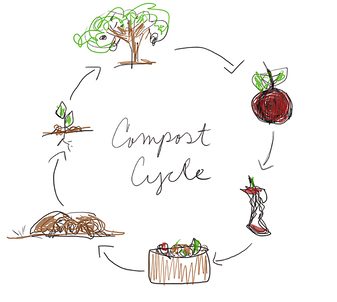The food that Marblehead High Schoolers throw out every day can take as long as two years to compost. Over this same period of time, MHS students have developed the school’s composting program, a project born in 2017, but one that they continue to perfect. Over the past two years, the basics of the program have remained the same; the program still encourages students to minimize the school’s waste production by composting and recycling items whenever possible. However, in the 2019-20 school year, this encouragement has become mandatory guidance, led by English teacher Connor Ryan, and the newly-established environmental honors society, NGSS, or the National Green Schools Society. By limiting the number of waste receptacles to only one bin for trash, one for recycling, and one for composting, there is less room for error, and as Mr. Ryan says, “fewer choices make it easier to make the right choice.” In fact, this system has led to a 75% decrease in the school’s daily trash output, going from 12 bags per day to just three.
“What we learned the hard way is that giving people too many options or too much choice is not really successful,” Mr. Ryan says, standing beside the composting headquarters, where the three waste bins stand every day for all three lunches. “The new system, instead of having multiple bins in multiple locations, centralizes everything. It allows for a much, much closer monitoring process. So now we can offer students advice about what to put where, we can remind them of how to do it, and we can keep it much cleaner and free from contamination.”
Volunteers fuel this improvement, guiding people toward the bin their trash belongs in under the advisement of Mr. Ryan, who monitors at least one of the three lunch blocks every day. “My goal is to make sure that you guys are here, talking to people, and to insure that everybody does what they’re supposed to do. As a bonus, I really, really like the idea of high school as a communal place, so I’ve gotten to know 30 or 40 people whom I didn’t have in class before and whom I don’t have in class this year. Now, we just know each other, which is the sort of thing that I can’t tie directly to the success of the program or teaching here, but I really, really like it. I think it’s important.” So do the students, who have ultimately put up little significant resistance. Even, junior Eliot Piper, who once teased Mr. Ryan with the label of the food police, is now on board with the program even amidst its humor: “It’s something to gag about, at the least, but if it does good, I mean, sure.” Others have developed their own composting systems at home, proving that the school’s composting program may be outside of the classroom, but it is surely an educational experience.
Volunteering at the table myself at least once a week, I’ve found a rhythm within the routine. The bins’ wheels hum against the linoleum floor as I set them up at the beginning of lunch, and Mr. Ryan will always make the same joking comments to students as they come up and throw out their trash. I’ll laugh with friends when they stop by, smile at strangers who remember to put their brown paper bag in the compost bin, and am pleasantly surprised by the students who are most careful with putting their waste in the correct bin–oftentimes the students I’d least expect. Something about this routine is comforting, inspiring even. Every lunch that I volunteer at, I see the faces of the students who are making a positive impact on our community, one piece of trash at a time. It’s small, but also a huge step forward in not only the school’s sustainability, but on the way we view environmental issues: as a community project. As Mr. Ryan says in respect to the composting, “If 95 people do a great job and then the last five people put trash in it, it’s all useless.” Without a school community that stands behind this mission, the program could never have improved so rapidly, but thanks to an accepting student body, the environmental impact of MHS is far from decomposing.

